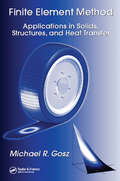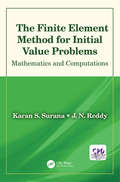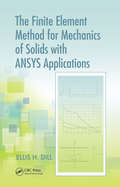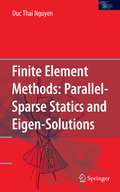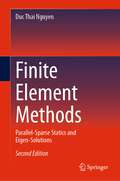- Table View
- List View
The Finite Element Method: A Primer
by Jacobo BielakThis textbook introduces the widely used numerical technique FEM in various engineering disciplines for the analysis of structures, heat transfer, fluid dynamics, and other physical phenomena. Appropriate for interested senior undergraduate engineering students and beginner graduate students in a one-semester introductory course, this book provides a clear understanding of the main issues in FEM. Looking at the FEM as a variational approximation method that uses localized piecewise polynomial basis functions for the solution of boundary-value problems (BVP) and initial boundary-value problems (IBVP), the book uses examples to apply this technique to various problems of physical interest, e.g., elasticity, heat conduction, advection-diffusion, etc. One-dimensional (1D) problems are presented first to make it easier to grasp the fundamental concepts associated with the formulation and application of the FEM; then, the methodology is extended to more challenging 2D and 3D problems that involve somewhat greater mathematical complexity. For simplicity, the book deals with problems that are specified in terms of a single set of state variables, such as displacements or temperature. Finally, due to the introductory nature of this text, only linear problems are considered.
Finite Element Method: Applications in Solids, Structures, and Heat Transfer (Mechanical Engineering)
by Michael R. GoszThe finite element method (FEM) is the dominant tool for numerical analysis in engineering, yet many engineers apply it without fully understanding all the principles. Learning the method can be challenging, but Mike Gosz has condensed the basic mathematics, concepts, and applications into a simple and easy-to-understand reference.Finite Element Method: Applications in Solids, Structures, and Heat Transfer navigates through linear, linear dynamic, and nonlinear finite elements with an emphasis on building confidence and familiarity with the method, not just the procedures. This book demystifies the assumptions made, the boundary conditions chosen, and whether or not proper failure criteria are used. It reviews the basic math underlying FEM, including matrix algebra, the Taylor series expansion and divergence theorem, vectors, tensors, and mechanics of continuous media.The author discusses applications to problems in solid mechanics, the steady-state heat equation, continuum and structural finite elements, linear transient analysis, small-strain plasticity, and geometrically nonlinear problems. He illustrates the material with 10 case studies, which define the problem, consider appropriate solution strategies, and warn against common pitfalls. Additionally, 35 interactive virtual reality modeling language files are available for download from the CRC Web site.For anyone first studying FEM or for those who simply wish to deepen their understanding, Finite Element Method: Applications in Solids, Structures, and Heat Transfer is the perfect resource.
Finite Element Method: Applications in Solids, Structures, and Heat Transfer (Mechanical Engineering)
by Michael R. GoszThe finite element method (FEM) is the dominant tool for numerical analysis in engineering, yet many engineers apply it without fully understanding all the principles. Learning the method can be challenging, but Mike Gosz has condensed the basic mathematics, concepts, and applications into a simple and easy-to-understand reference.Finite Element Method: Applications in Solids, Structures, and Heat Transfer navigates through linear, linear dynamic, and nonlinear finite elements with an emphasis on building confidence and familiarity with the method, not just the procedures. This book demystifies the assumptions made, the boundary conditions chosen, and whether or not proper failure criteria are used. It reviews the basic math underlying FEM, including matrix algebra, the Taylor series expansion and divergence theorem, vectors, tensors, and mechanics of continuous media.The author discusses applications to problems in solid mechanics, the steady-state heat equation, continuum and structural finite elements, linear transient analysis, small-strain plasticity, and geometrically nonlinear problems. He illustrates the material with 10 case studies, which define the problem, consider appropriate solution strategies, and warn against common pitfalls. Additionally, 35 interactive virtual reality modeling language files are available for download from the CRC Web site.For anyone first studying FEM or for those who simply wish to deepen their understanding, Finite Element Method: Applications in Solids, Structures, and Heat Transfer is the perfect resource.
Finite Element Method: Element Solutions
by Yongtao LyuThis textbook is intended to be used by the senior engineering undergraduate and the graduate student. Nowadays, the finite element method has become one of the most widely used techniques in all the engineering fields, including aerospace engineering, mechanical engineering, biomedical engineering, etc. To unveil the FE technique, the textbook provides a detailed description of the finite element method, starting from the most important basic theoretical basis, e.g., the Galerkin method, the variational principle, followed by the detailed description of the various types of finite elements, including the bar, the beam, the triangular, the rectangular, the 3D elements. The primary aim of the textbook is to provide a comprehensive description of the FE solutions using different types of elements. Therefore, the properties of different elements and the solution discrepancies caused by using different elements are highlighted in the book. Thus, the textbook is very helpful for engineers to understand the behaviours of different types of elements. Additionally, the textbook can help the students and engineers write FE codes based on the theories presented in the book. Furthermore, the textbook can serve as the basis for some advanced computational mechanics courses, such as the nonlinear finite element method.
The Finite Element Method: Basic Concepts and Applications with MATLAB, MAPLE, and COMSOL, Third Edition (Series in Computational and Physical Processes in Mechanics and Thermal Sciences)
by Darrell W. Pepper Juan C. HeinrichThis self-explanatory guide introduces the basic fundamentals of the Finite Element Method in a clear manner using comprehensive examples. Beginning with the concept of one-dimensional heat transfer, the first chapters include one-dimensional problems that can be solved by inspection. The book progresses through more detailed two-dimensional elements to three-dimensional elements, including discussions on various applications, and ending with introductory chapters on the boundary element and meshless methods, where more input data must be provided to solve problems. Emphasis is placed on the development of the discrete set of algebraic equations. The example problems and exercises in each chapter explain the procedure for defining and organizing the required initial and boundary condition data for a specific problem, and computer code listings in MATLAB and MAPLE are included for setting up the examples within the text, including COMSOL files. Widely used as an introductory Finite Element Method text since 1992 and used in past ASME short courses and AIAA home study courses, this text is intended for undergraduate and graduate students taking Finite Element Methodology courses, engineers working in the industry that need to become familiar with the FEM, and engineers working in the field of heat transfer. It can also be used for distance education courses that can be conducted on the web. Highlights of the new edition include:- Inclusion of MATLAB, MAPLE code listings, along with several COMSOL files, for the example problems within the text. Power point presentations per chapter and a solution manual are also available from the web. - Additional introductory chapters on the boundary element method and the meshless method.- Revised and updated content.-Simple and easy to follow guidelines for understanding and applying the Finite Element Method.
The Finite Element Method: Basic Concepts and Applications with MATLAB, MAPLE, and COMSOL, Third Edition (Series in Computational and Physical Processes in Mechanics and Thermal Sciences)
by Darrell W. Pepper Juan C. HeinrichThis self-explanatory guide introduces the basic fundamentals of the Finite Element Method in a clear manner using comprehensive examples. Beginning with the concept of one-dimensional heat transfer, the first chapters include one-dimensional problems that can be solved by inspection. The book progresses through more detailed two-dimensional elements to three-dimensional elements, including discussions on various applications, and ending with introductory chapters on the boundary element and meshless methods, where more input data must be provided to solve problems. Emphasis is placed on the development of the discrete set of algebraic equations. The example problems and exercises in each chapter explain the procedure for defining and organizing the required initial and boundary condition data for a specific problem, and computer code listings in MATLAB and MAPLE are included for setting up the examples within the text, including COMSOL files. Widely used as an introductory Finite Element Method text since 1992 and used in past ASME short courses and AIAA home study courses, this text is intended for undergraduate and graduate students taking Finite Element Methodology courses, engineers working in the industry that need to become familiar with the FEM, and engineers working in the field of heat transfer. It can also be used for distance education courses that can be conducted on the web. Highlights of the new edition include:- Inclusion of MATLAB, MAPLE code listings, along with several COMSOL files, for the example problems within the text. Power point presentations per chapter and a solution manual are also available from the web. - Additional introductory chapters on the boundary element method and the meshless method.- Revised and updated content.-Simple and easy to follow guidelines for understanding and applying the Finite Element Method.
Finite Element Method Analysis for Ice Class Vessels (Synthesis Lectures on Ocean Systems Engineering)
by Alexander Arnfinn OlsenThis book provides ship designers with clear guidance on alternative design procedures for hull side structures, power requirements, and propeller strength assessment based on the Finite Element Method for Baltic Ice Class Vessels. Through this comprehensive guide, readers will learn the intricacies of designing vessels capable of navigating the harsh ice conditions of the Baltic Sea. The chapters cover topics such as ice strengthening designs using direct calculation approaches, power requirement calculations for ice class vessels, and strength analysis of propellers. The authors present an expert analysis of these critical aspects, offering practical solutions and methodologies that are essential for marine engineers and naval architects. This book is a must-read for anyone involved in the design and construction of ice-class vessels, providing invaluable insights into the latest research and best practices in the field. This guide is indispensable for naval architects, marine engineering students, marine surveyors, and professionals working in maritime defense and shipping registries. It serves as a reference for academics and students in marine design and engineering, as well as a textbook for marine engineering courses. With contributions from experienced practitioners in the field, this book offers both theoretical perspectives and practical case studies that will benefit anyone involved in the design and operation of ice-class vessels.
The Finite Element Method and Applications in Engineering Using ANSYS®
by Erdogan Madenci Ibrahim GuvenThis textbook offers theoretical and practical knowledge of the finite element method. The book equips readers with the skills required to analyze engineering problems using ANSYS®, a commercially available FEA program. Revised and updated, this new edition presents the most current ANSYS® commands and ANSYS® screen shots, as well as modeling steps for each example problem. This self-contained, introductory text minimizes the need for additional reference material by covering both the fundamental topics in finite element methods and advanced topics concerning modeling and analysis. It focuses on the use of ANSYS® through both the Graphics User Interface (GUI) and the ANSYS® Parametric Design Language (APDL). Extensive examples from a range of engineering disciplines are presented in a straightforward, step-by-step fashion. Key topics include: • An introduction to FEM • Fundamentals and analysis capabilities of ANSYS® • Fundamentals of discretization and approximation functions • Modeling techniques and mesh generation in ANSYS®• Weighted residuals and minimum potential energy • Development of macro files • Linear structural analysis • Heat transfer and moisture diffusion • Nonlinear structural problems • Advanced subjects such as submodeling, substructuring, interaction with external files, and modification of ANSYS®-GUI Electronic supplementary material for using ANSYS® can be found at http://link.springer.com/book/10.1007/978-1-4899-7550-8. This convenient online feature, which includes color figures, screen shots and input files for sample problems, allows for regeneration on the reader’s own computer. Students, researchers, and practitioners alike will find this an essential guide to predicting and simulating the physical behavior of complex engineering systems."
The Finite Element Method and Applications in Engineering Using ANSYS®
by Erdogan Madenci Ibrahim GuvenThis user-friendly book provides the reader with a theoretical and practical knowledge of the finite element method (FEM) and with the skills required to analyze engineering problems with ANSYS®. A self-contained, introductory text, it minimizes the need for additional reference material, covering the fundamental topics in FEM as well as advanced topics concerning modeling and analysis with ANSYS®. Extensive examples from various engineering disciplines are presented in a step-by-step fashion, focusing on the use of ANSYS® through both the Graphics User Interface (GUI) and the ANSYS® Parametric Design Language (APDL). Additional materials for this book, including the "input" files for the example problems, as well as the colored figures and screen shots, allowing them to be regenerated on the reader’s own computer, may be downloaded from http://extras.springer.com.
The Finite Element Method for Boundary Value Problems: Mathematics and Computations (Applied And Computational Mechanics Ser.)
by Karan S. Surana J. N. ReddyWritten by two well-respected experts in the field, The Finite Element Method for Boundary Value Problems: Mathematics and Computations bridges the gap between applied mathematics and application-oriented computational studies using FEM. Mathematically rigorous, the FEM is presented as a method of approximation for differential operators that are mathematically classified as self-adjoint, non-self-adjoint, and non-linear, thus addressing totality of all BVPs in various areas of engineering, applied mathematics, and physical sciences. These classes of operators are utilized in various methods of approximation: Galerkin method, Petrov-Galerkin Method, weighted residual method, Galerkin method with weak form, least squares method based on residual functional, etc. to establish unconditionally stable finite element computational processes using calculus of variations. Readers are able to grasp the mathematical foundation of finite element method as well as its versatility of applications. h-, p-, and k-versions of finite element method, hierarchical approximations, convergence, error estimation, error computation, and adaptivity are additional significant aspects of this book.
The Finite Element Method for Boundary Value Problems: Mathematics and Computations (Applied And Computational Mechanics Ser.)
by Karan S. Surana J. N. ReddyWritten by two well-respected experts in the field, The Finite Element Method for Boundary Value Problems: Mathematics and Computations bridges the gap between applied mathematics and application-oriented computational studies using FEM. Mathematically rigorous, the FEM is presented as a method of approximation for differential operators that are mathematically classified as self-adjoint, non-self-adjoint, and non-linear, thus addressing totality of all BVPs in various areas of engineering, applied mathematics, and physical sciences. These classes of operators are utilized in various methods of approximation: Galerkin method, Petrov-Galerkin Method, weighted residual method, Galerkin method with weak form, least squares method based on residual functional, etc. to establish unconditionally stable finite element computational processes using calculus of variations. Readers are able to grasp the mathematical foundation of finite element method as well as its versatility of applications. h-, p-, and k-versions of finite element method, hierarchical approximations, convergence, error estimation, error computation, and adaptivity are additional significant aspects of this book.
Finite Element Method for Hemivariational Inequalities: Theory, Methods and Applications (Nonconvex Optimization and Its Applications #35)
by J. Haslinger M. Miettinen Panagiotis D. PanagiotopoulosHemivariational inequalities represent an important class of problems in nonsmooth and nonconvex mechanics. By means of them, problems with nonmonotone, possibly multivalued, constitutive laws can be formulated, mathematically analyzed and finally numerically solved. The present book gives a rigorous analysis of finite element approximation for a class of hemivariational inequalities of elliptic and parabolic type. Finite element models are described and their convergence properties are established. Discretized models are numerically treated as nonconvex and nonsmooth optimization problems. The book includes a comprehensive description of typical representants of nonsmooth optimization methods. Basic knowledge of finite element mathematics, functional and nonsmooth analysis is needed. The book is self-contained, and all necessary results from these disciplines are summarized in the introductory chapter. Audience: Engineers and applied mathematicians at universities and working in industry. Also graduate-level students in advanced nonlinear computational mechanics, mathematics of finite elements and approximation theory. Chapter 1 includes the necessary prerequisite materials.
The Finite Element Method for Initial Value Problems: Mathematics and Computations
by Karan S. Surana J. N. ReddyUnlike most finite element books that cover time dependent processes (IVPs) in a cursory manner, The Finite Element Method for Initial Value Problems: Mathematics and Computations focuses on the mathematical details as well as applications of space-time coupled and space-time decoupled finite element methods for IVPs. Space-time operator classification, space-time methods of approximation, and space-time calculus of variations are used to establish unconditional stability of space-time methods during the evolution. Space-time decoupled methods are also presented with the same rigor. Stability of space-time decoupled methods, time integration of ODEs including the finite element method in time are presented in detail with applications. Modal basis, normal mode synthesis techniques, error estimation, and a posteriori error computations for space-time coupled as well as space-time decoupled methods are presented. This book is aimed at a second-semester graduate level course in FEM.
The Finite Element Method for Initial Value Problems: Mathematics and Computations
by Karan S. Surana J. N. ReddyUnlike most finite element books that cover time dependent processes (IVPs) in a cursory manner, The Finite Element Method for Initial Value Problems: Mathematics and Computations focuses on the mathematical details as well as applications of space-time coupled and space-time decoupled finite element methods for IVPs. Space-time operator classification, space-time methods of approximation, and space-time calculus of variations are used to establish unconditional stability of space-time methods during the evolution. Space-time decoupled methods are also presented with the same rigor. Stability of space-time decoupled methods, time integration of ODEs including the finite element method in time are presented in detail with applications. Modal basis, normal mode synthesis techniques, error estimation, and a posteriori error computations for space-time coupled as well as space-time decoupled methods are presented. This book is aimed at a second-semester graduate level course in FEM.
The Finite Element Method for Mechanics of Solids with ANSYS Applications (Advances In Engineering Ser.)
by Ellis H. DillWhile the finite element method (FEM) has become the standard technique used to solve static and dynamic problems associated with structures and machines, ANSYS software has developed into the engineer's software of choice to model and numerically solve those problems. An invaluable tool to help engineers master and optimize analysis, The Finite El
The Finite Element Method in Charged Particle Optics (The Springer International Series in Engineering and Computer Science #519)
by Anjam KhursheedIn the span of only a few decades, the finite element method has become an important numerical technique for solving problems in the subject of charged particle optics. The situation has now developed up to the point where finite element simulation software is sold commercially and routinely used in industry. The introduction of the finite element method in charged particle optics came by way of a PHD thesis written by Eric Munro at the University of Cambridge, England, in 1971 [1], shortly after the first papers appeared on its use to solve Electrical Engineering problems in the late sixties. Although many papers on the use of the finite element method in charged particle optics have been published since Munro's pioneering work, its development in this area has not as yet appeared in any textbook. This fact must be understood within a broader context. The first textbook on the finite element method in Electrical Engineering was published in 1983 [2]. At present, there are only a handful of other books that describe it in relation to Electrical Engineering topics [3], let alone charged particle optics. This is but a tiny fraction of the books dedicated to the finite element method in other subjects such as Civil Engineering. The motivation to write this book comes from the need to redress this imbalance. There is also another important reason for writing this book.
The Finite Element Method in Heat Transfer and Fluid Dynamics (Applied And Computational Mechanics Ser.)
by J. N. Reddy D. K. GartlingAs Computational Fluid Dynamics (CFD) and Computational Heat Transfer (CHT) evolve and become increasingly important in standard engineering design and analysis practice, users require a solid understanding of mechanics and numerical methods to make optimal use of available software. The Finite Element Method in Heat Transfer and Fluid Dynamics, Th
Finite Element Method in Machining Processes (SpringerBriefs in Applied Sciences and Technology)
by Angelos P. MarkopoulosFinite Element Method in Machining Processes provides a concise study on the way the Finite Element Method (FEM) is used in the case of manufacturing processes, primarily in machining. The basics of this kind of modeling are detailed to create a reference that will provide guidelines for those who start to study this method now, but also for scientists already involved in FEM and want to expand their research.A discussion on FEM, formulations, and techniques currently in use is followed up by machining case studies. Orthogonal cutting, oblique cutting, 3D simulations for turning and milling, grinding, and state-of-the-art topics such as high speed machining and micromachining are explained with relevant examples. This is all supported by a literature review and a reference list for further study.As FEM is a key method for researchers in the manufacturing and especially in the machining sector, Finite Element Method in Machining Processes is a key reference for students studying manufacturing processes but also for industry professionals.
The Finite Element Method in Structural Mechanics: Principles and Practice of Design of Field-consistent Elements for Structural and Solid Mechanics (Solid Mechanics and Its Applications #24)
by Gangan PrathapThis book is not intended to be a text-book, delineating the full scope of finite element methodology, nor is it a comprehensive handbook of modern finite element practice for the finite element engineer. There are enough books that serve to do these and more. It is however intended as a monograph or treatise on a very specific area - the design of robust and accurate elements for applications in struc tural mechanics. It attempts to describe the epistemological conflict between the principles in finite element technology that can be described as Art and those that have a scientific basis invested in it and which can be admitted as science as the subject evolved and came to be accepted. The principles of structural mechanics as a branch of physics are well founded and have a sound scientific basis. The mathematical description of it has also a long history and is rigorously based on the infinitesimal and variational calculus. Of much more recent origin has been the branch of knowledge dealing with the numerical modelling of the beha viour of structural material. The most powerful method available to do this today is the finite element method. It is eminently suited to carry out the entire cycle of design and analysis of a structural configuration on a digital computer.
The finite element method in the 1990’s: A Book Dedicated to O.C. Zienkiewicz
by Eugenio Onate J. Periaux A. SamuelssonEdited on the occasion of Prof. Olgierd C. Zienkiewicz' 70th birthday, this book contains original contributions from eminent scientists dealing with a wide range of theoretical aspects of the Finite Element Method and its application to a variety of engineering problems. The book provides an overview of the state-of-the-art of finite element technology in the last decade of the 20th century.
The Finite Element Method: Theory, Implementation, and Applications (Texts in Computational Science and Engineering #10)
by Mats G. Larson Fredrik BengzonThis book gives an introduction to the finite element method as a general computational method for solving partial differential equations approximately. Our approach is mathematical in nature with a strong focus on the underlying mathematical principles, such as approximation properties of piecewise polynomial spaces, and variational formulations of partial differential equations, but with a minimum level of advanced mathematical machinery from functional analysis and partial differential equations. In principle, the material should be accessible to students with only knowledge of calculus of several variables, basic partial differential equations, and linear algebra, as the necessary concepts from more advanced analysis are introduced when needed. Throughout the text we emphasize implementation of the involved algorithms, and have therefore mixed mathematical theory with concrete computer code using the numerical software MATLAB is and its PDE-Toolbox. We have also had the ambition to cover some of the most important applications of finite elements and the basic finite element methods developed for those applications, including diffusion and transport phenomena, solid and fluid mechanics, and also electromagnetics.
The Finite Element Method Using MATLAB (Mechanical and Aerospace Engineering Series)
by Young W. Kwon Hyochoong BangExpanded to include a broader range of problems than the bestselling first edition, Finite Element Method Using MATLAB: Second Edition presents finite element approximation concepts, formulation, and programming in a format that effectively streamlines the learning process. It is written from a general engineering and mathematical perspective rather than that of a solid/structural mechanics basis.What's new in the Second Edition?Each chapter in the Second Edition now includes an overview that outlines the contents and purpose of each chapter. The authors have also added a new chapter of special topics in applications, including cracks, semi-infinite and infinite domains, buckling, and thermal stress. They discuss three different linearization techniques to solve nonlinear differential equations. Also included are new sections on shell formulations and MATLAB programs. These enhancements increase the book's already significant value both as a self-study text and a reference for practicing engineers and scientists.
Finite Element Methods: Parallel-Sparse Statics and Eigen-Solutions
by Duc Thai NguyenFinite element methods (FEM), and its associated computer software have been widely accepted as one of the most effective general tools for solving large-scale, practical engineering and science applications. For implicit finite element codes, it is a well-known fact that efficient equation and eigen-solvers play critical roles in solving large-scale, practical engineering/science problems. Sparse matrix technologies have been evolved and become mature enough that all popular, commercialized FEM codes have already inserted sparse solvers into their software. However, a few FEM books have detailed discussions about Lanczos eigen-solvers, or explain domain decomposition (DD) finite element formulation (including detailed hand-calculator numerical examples) for parallel computing purposes. The materials from this book have been evolved over the past several years through the author's research work, and graduate courses.
Finite Element Methods: Parallel-Sparse Statics and Eigen-Solutions
by Duc Thai NguyenThis new edition includes three new chapters, 7 through 9, that have very broad, practical applications in engineering and science. In addition, the author’s latest research results incorporated into the new textbook demonstrates better performance than the popular METIS software for partitioning graphs, partitioning finite element meshes, and producing fill-reducing orderings for sparse matrices. The new Chapter 8, and its pre-requisite, Chapter 7, present a state-of-the-art algorithm for computing the shortest paths for real-life (large-scale) transportation networks with minimum computational time. This approach has not yet appeared in any existing textbooks and it could open the doors for other transportation engineering applications. Chapter 9 vastly expands the scope of the previous edition by including sensitivity (gradient) computation and MATLAB’s built-in function “fmincon” for obtaining the optimum (or best) solution for general engineering problems.
Finite Element Methods and Their Applications (Scientific Computation)
by Zhangxin ChenIntroduce every concept in the simplest setting and to maintain a level of treatment that is as rigorous as possible without being unnecessarily abstract. Contains unique recent developments of various finite elements such as nonconforming, mixed, discontinuous, characteristic, and adaptive finite elements, along with their applications. Describes unique recent applications of finite element methods to important fields such as multiphase flows in porous media and semiconductor modelling. Treats the three major types of partial differential equations, i.e., elliptic, parabolic, and hyperbolic equations.

